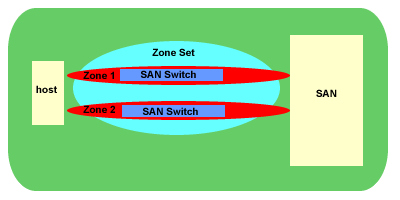
Zoning Architecture
Zoning is switch function that allows devices within the fabric to be logically segmented into groups that can communicate with each other. When a device (host) logins into a fabric it is registered by the Name Server, it goes through a discovery process with other devices registered as SCSI FCP in the Name Server.
A zone conists of a single HBA port and one or more storage ports. A collection of zones is called a zoneset A zoneset can be active or inactive but only one zoneset can be active at any one time within a switch. Remember a SAN port can be in multiple zones as many hosts will be sharing this port. A common way to setup zoning is to use the WWN of the attached hosts and ports but there are many ways:
The diagram below has a single host with two HBA cards installed connecting to two different switches, both switches then connect to a SAN. Each HBA card has its own zone and both zones are placed into a zoneset. If in the event one HBA card goes down the other card can continue to have access to the data.

For detailed information on setting up zones on the M-series, B-series and MDS-series switches go to here
Hard and Soft zoning
There are two ways to zone hard and soft, hard zoning is using the physical connection to block zone access and soft zoning uses software to block access to a zone i.e software within a switch.
LUN Masking
There is other zoning which is called LUN masking, this is normally handled by the SAN array and only allows specific hosts to see specific devices within the array, this is particular import for windows, as window will try and write volume labels to a disk devices thus corrupting any data on the disk.